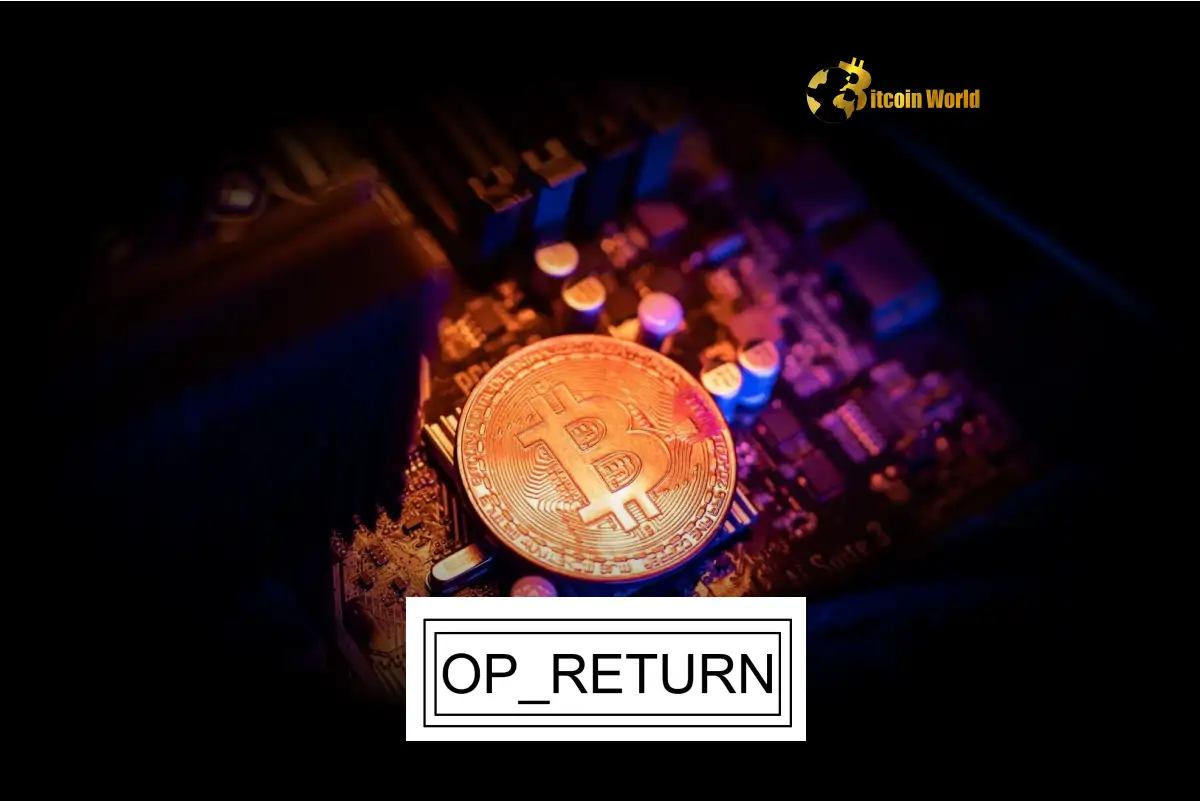


0
0

The world of Bitcoin is rarely quiet, and a recent proposal from Bitcoin Core developers has ignited a significant discussion, bordering on a full-blown crypto debate. At the heart of the matter is a technical tweak with potentially broad implications for how data is stored on the blockchain: the humble Bitcoin OP_RETURN output.
First off, let’s break down what we’re talking about. In simple terms, an OP_RETURN output is a special type of transaction output on the Bitcoin network. Unlike regular outputs that send Bitcoin to a specific address, an OP_RETURN output is provably unspendable. Its primary purpose is to allow a small amount of arbitrary data to be embedded directly into the blockchain, typically for applications built on top of Bitcoin.
The key thing here is the data limit. Currently, OP_RETURN outputs are capped at 80 bytes. This limit was introduced years ago precisely to prevent the blockchain from being filled with excessive, non-financial data, which could contribute to something called UTXO bloat.
So, why does this seemingly small technical detail matter? Because how data is stored and managed directly impacts the efficiency, cost, and decentralization of the entire Bitcoin network. Changes here are a big deal.
A group of prominent Bitcoin developers, specifically from the Bitcoin Core project, have put forward a proposal to remove the existing 80-byte size limit on OP_RETURN outputs entirely. Their argument is based on a technical observation: the current limit isn’t actually achieving its goal effectively and, in some cases, is making things worse.
Here’s their reasoning:
In essence, the developers argue that the current limit is an ineffective dam that forces water (data) to flow around it in ways that cause more erosion (UTXO bloat) downstream. Removing the dam, they suggest, could lead to a more controlled and less harmful flow.
As you might expect in the often-passionate world of cryptocurrency, this proposal hasn’t been met with universal acclaim. It has sparked a significant crypto debate, pitting technical efficiency arguments against concerns about network use and governance.
Prominent critics have voiced their opposition. Among them are figures like Samson Mow, CEO of JAN3, and Marty Bent from Ten31 Fund and the popular ‘Tales from the Crypt’ podcast. Their core arguments often revolve around:
This isn’t just a technical disagreement; it touches upon philosophical questions about what the Bitcoin network is for and how its scarce resources (block space and node capacity) should be used.
Let’s try to summarize the potential upsides and downsides of removing the Bitcoin OP_RETURN limit:
Potential Benefits (According to Proponents):
Potential Challenges (According to Critics):
The debate highlights a classic tension in decentralized systems: how to balance flexibility and innovation with stability and resistance to abuse. The Bitcoin developers proposing the change see it as a technical optimization to fix an existing problem, while critics see it as potentially introducing new, worse problems and bypassing established consensus-building processes.
Let’s zoom in on UTXO bloat, as it’s central to the developers’ argument. The UTXO set (Unspent Transaction Output set) is essentially the list of all Bitcoin that currently exists and is available to be spent. Every full node on the Bitcoin network needs to keep track of this set to validate new transactions. When you receive Bitcoin, it’s added to the UTXO set as an output you can spend. When you spend it, that output is marked as spent, and new outputs are created for the recipient and any change.
A large UTXO set requires more memory and processing power for nodes. If the set grows too large, it can make it harder and more expensive to run a full node, potentially leading to fewer nodes and thus less decentralization. The 80-byte OP_RETURN limit was intended to keep outputs small and unspendable, thus not contributing to the *spendable* UTXO set directly, but the *number* of outputs still matters.
The developers’ point is that workarounds to the 80-byte limit often involve creating *more* outputs (even if some are OP_RETURN or other types), which increases the *size* and *complexity* of the UTXO set data that nodes must manage, arguably causing worse bloat than a single larger OP_RETURN output might.
For now, this is just a proposal from a group of Bitcoin developers. As The Block reported, no release date has been set for any software update that would include this change. The nature of Bitcoin development is iterative and relies heavily on discussion, review, and eventual consensus among a distributed group of developers, users, miners, and businesses.
This crypto debate will likely continue to play out on mailing lists, in online forums, and during developer calls. The technical merits of the proposal will be scrutinized, the potential risks debated, and the community’s sentiment gauged. It’s a prime example of how changes, even seemingly minor ones, in a decentralized system like the Bitcoin network require careful consideration and broad buy-in.
The proposal by Bitcoin developers to remove the 80-byte limit on Bitcoin OP_RETURN outputs is more than just a technical detail; it’s a catalyst for a broader crypto debate about the future use and health of the Bitcoin network. While proponents argue it’s a necessary step to combat inefficient workarounds and reduce UTXO bloat, critics raise valid concerns about potential spam, increased node costs, and the very nature of Bitcoin’s purpose.
This discussion underscores the decentralized and often contentious nature of Bitcoin development. Reaching consensus on significant changes is a slow, deliberate process, reflecting the network’s resistance to rapid alteration. How this debate evolves will be crucial to watch, as it could influence how data is managed on the blockchain for years to come.
To learn more about the latest Bitcoin trends, explore our article on key developments shaping Bitcoin network health and development.
0
0
 Gerencie todo seu criptograma, NFT e DeFi de um só lugar
Gerencie todo seu criptograma, NFT e DeFi de um só lugarConecte com segurança o portfólio que você está usando para começar.